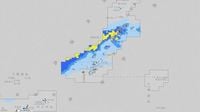As the Golden Week comes to a close, a significant shift in weather patterns is set to affect much of Japan. On May 6, 2025, widespread rain is expected across western and eastern regions, marking a stark contrast to the sunny spells enjoyed earlier in the week.
According to the Japan Meteorological Agency, the Kanto region will begin experiencing rain by noon on May 6. This precipitation is anticipated to be heavy in some areas, particularly in western Japan, where thunderstorms may accompany the rainfall. The forecast indicates that even if the rain temporarily halts, showers and thunderstorms could return in the afternoon, creating a rather unpredictable weather day.
The forecast for daytime temperatures on May 6 shows a significant drop compared to the previous day, with highs around 20 degrees Celsius expected from Kanto to Kyushu. This temperature drop will necessitate warmer clothing, especially in the evening when temperatures will feel quite chilly.
Minimum temperatures across various regions are projected as follows: Sapporo at 9 degrees Celsius, Sendai at 10 degrees, Niigata at 12 degrees, and Tokyo at 15 degrees. Meanwhile, Nagano is expected to see a minimum of 10 degrees, which is 5 degrees higher than the mid-May average. Cities like Nagoya and Osaka will have minimums of 14 and 15 degrees respectively, with Hiroshima and Fukuoka also cooler than usual at 14 and 15 degrees.
The maximum temperatures are also expected to be lower than average, with Sapporo reaching 19 degrees, Sendai 16 degrees, and Tokyo 19 degrees, all significantly cooler than the previous week. For instance, Nagoya is forecasted to have a maximum of 19 degrees, which is 6 degrees lower than the early April average.
In Okinawa, the situation is more critical as the region braces for potentially severe weather. The Okinawa Meteorological Observatory has issued warnings for heavy rain, particularly on the night of May 6, where rainfall could reach warning-level intensity depending on the development of rain clouds. Areas on Okinawa's main island could see rainfall rates of up to 30mm per hour, prompting officials to advise residents to be vigilant against sediment disasters, flooding in low-lying areas, and rising river levels.
Local authorities have urged caution regarding lightning and sudden gusts of wind, including tornadoes, which could occur on May 6. The atmosphere in Okinawa is expected to be very unstable due to the influence of a frontal system and humid air, leading to the likelihood of heavy rain throughout the day.
The forecast for Okinawa also suggests that the rainy season is approaching, with many rainy days expected in the coming week. The average start of the rainy season in Okinawa is around May 10, which means residents should prepare for more significant rainfall in the days ahead.
Furthermore, from May 9 to May 10, heavy rain is anticipated primarily from Kyushu to Kanto, with southern Kyushu likely to experience the heaviest downpours. The Kanto Koshin region's rainy season is still a way off, but residents are encouraged to take preemptive measures, such as cleaning gutters and improving drainage around their homes, to mitigate potential flooding.
As the week progresses, temperatures are predicted to rise, bringing summer-like conditions to many areas from Kanto to Kyushu. The following day, May 7, will see a gradual recovery in weather, with returning sunshine and warmer temperatures expected.
However, weather patterns will remain dynamic, with forecasts indicating that May 8 will be predominantly sunny nationwide, but rain will return from the west on May 9. By May 10, strong winds may lead to rough weather conditions, particularly in the Kanto and Kinki regions.
In summary, as Japan transitions from the Golden Week festivities, residents should brace for a variety of weather conditions, from heavy rain and thunderstorms in the west and east to a gradual warming trend following the initial downpours. The unpredictable nature of spring weather in Japan remains a critical consideration for those planning outdoor activities in the coming days.



